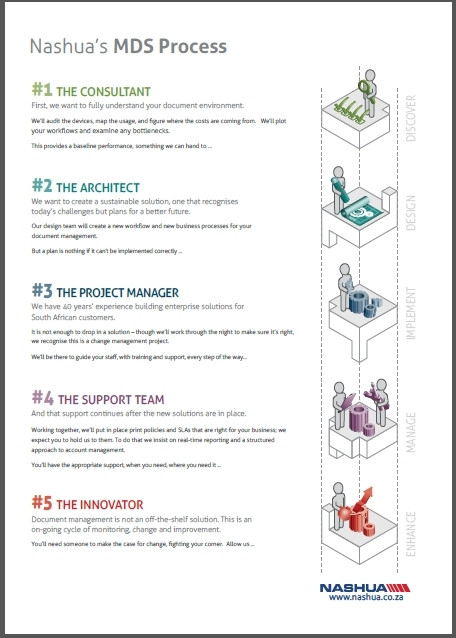So, after realising that company has to have a Nashua managed document services (MDS) solution in order to stay competitive and meet all legal compliance issues with regards to your document workflow, it is time for Nashua to send in its specialised teams to learn more about your business.
An MDS implementation is not something that comes out of a box and gets plugged into a company's existing infrastructure. It involves five stages, beginning with a discovery stage and concluding with an enhancement and innovation stage.
Each of these stages is designed to identify bottlenecks, find possible problems that could arise in the future and save a company time and money.
The consultant: discover and understand the company
Nashua begins any MDS implementation by sending in a team of consultants to learn more about the business. It will look at what a company's current operating costs are, the number of employees in the company - including any satellite or off-site teams. Current business objectives are taken into account and Nashua ensures it has a firm understanding of all document life cycles - from creation to storage.
In the discovery stage, current technology is assessed and any financial contracts and commitments are included. With this thorough audit of how a company operates, Nashua is then able to compile a report on how well the company is operating now, and how an MDS solution will help to improve it.
The architect: time to design a custom MDS solution
It is now back to the drawing board as such for Nashua, as its team of architects analyse the information collected in the discovery stage. In order to build the ideal solution, Nashua looks at the business objectives found during the discovery stage, and builds the solution around these objectives.
The idea is not to disrupt a company's current business, but instead find ways to streamline it. The design stage also takes into account devices needed for document output. For example, it will identify where printers will need to be installed in the event that a document needs to be filed, it will also identify what storage solutions need to be implemented, local or cloud-based for long-term document archiving or short-term storage. Backup, anti-virus, document retrieval and workflow digitisation software packages will also be recommended.
In each of the above examples, Nashua will only recommend the latest, best-of-breed options that not only suit the company's needs now, but will continue to do so in the future.
The project manager: implementation begins
Once the company and Nashua have agreed on a budget and timeline based on the above two processes, Nashua will begin migrating a company's current document workflows to the tailored MDS solution. It is not so much a case of stopping a company's entire current workflow process to implement the new one, but instead involves a gradual roll-out, where the biggest bottlenecks or problems are the first to be addressed.
Nashua employs a "stacking" process, whereby new equipment and software solutions are installed that will run alongside current devices to make sure the company experiences as few disruptions as possible.
During this stage, Nashua will host training sessions, helping to ensure an employee's transition to the new solution is a painless one. Specialised teams will also remain on-site for any problems that may arise during the implementation stage.
All implementation and transition phases are carried out following a custom framework built on experience and best practices, following the Project Management Body of Knowledge (PMBOK) methodology.
The support team: support and management
Once employees have been through the required training courses and the MDS solution is fully operational, Nashua's on-site support team is available 24/7 for any problems that may occur.
Each of the support technicians is equipped with a mobile device with access to Nashua's Mobile Application Service Call management app. With this app, the technician has access to the latest firmware updates for all devices installed at the site. He or she can also download the latest drivers and access each of the device vendors' knowledge bases should they need to troubleshoot an installed device.
The idea here is because a Nashua MDS solution incorporates devices and software from third-party vendors, there may be a delay in the time the third-party gets back with a fix, when the problem can be alleviated in a few minutes without relying on anyone else.
Reporting is also a big part of this stage. Nashua checks that a company's document activity is in line with any agreed environmental policies and incorporates notifications on users' computers to remind them to keep printing to a minimum.
The innovator: innovation and enhancement
Nashua's policy is: "Good enough is simply not enough". In keeping up with this trend, it continually monitors the new MDS solution, looking for ways to improve it.
The IT industry never stands still, with newer, faster and sometimes more cost-effective solutions coming out. Should a new printer or storage solution become available that will be beneficial to a business, Nashua will make a recommendation in its monthly reports.
A Nashua MDS solution is one that takes hours of planning, where Nashua is at the company's side every step of the way. Once the implementation has been completed, the solution is revised to find new ways to streamline a business's document workflow process. There are always new innovations in the technology industry and companies need to keep abreast with them in order to streamline their business processes.

Share